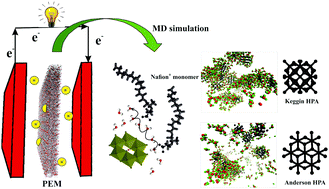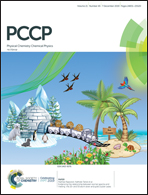Does the addition of a heteropoly acid change the water percolation threshold of PFSA membranes?†
Abstract
A large system containing heteropoly acids (HPAs) and Nafion® 117 was simulated and studied to verify whether the additive particles affect the formation of the water percolating network or not. Two structures of HPA particles were considered as dopants, i.e. H9AlW6O24 and H3PW12O40. The SAXS simulation revealed that HPA particle addition to the membrane matrix leads to an increased order in the abundance and size of the hydrophilic region beside an expansion of the distance between the ionic domains. The morphological assessment shows that the hydrophilic phase domains in the HPA-doped Nafion® were spaced further apart than in the undoped membrane. These results show that adding HPA particles to the PFSA membrane reduces the so-called dead-pockets and makes the water channels more interconnected. For undoped Nafion®, the so-called percolating hydration level (λp) was 5.63. In other words, according to these results, approximately 8 wt% of water molecules are required to establish a spanning water network. The H9AlW6O24 and H3PW12O40 particles directly influence the morphology of water clusters and reduce by 10.12% and 17.41% the required hydration level to reach the percolation threshold, respectively.



 Please wait while we load your content...
Please wait while we load your content...